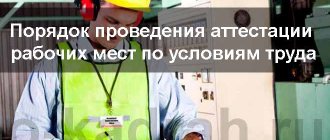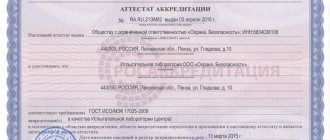In what cases is an unscheduled special assessment of working conditions required?
Assessment of hazardous working conditions can be carried out by various organizations vested with appropriate powers. The choice of a specific institution that will deal with VSUT depends on such parameters as the specifics of the enterprise, the scope of its activities, methods of workplace research, etc.
You may be interested in : Additional payment for hazardous working conditions
The conditions and methods of implementation are regulated by labor legislation, namely by order of the Ministry of Labor No. 549n. The most common situations when an unscheduled special assessment of working conditions is carried out are:
- checking the compliance of the qualifications of the working personnel with production requirements immediately after the recertification procedure;
- monitoring management's fulfillment of obligations to accrue and pay monetary compensation for work under the influence of harmful or dangerous production factors;
- checking the quality of equipment, production premises, technologies and other related characteristics for compliance with legislative standards on labor protection;
- checking the availability of collective protective equipment (fire alarms, ventilation systems, fire extinguishing equipment, etc.) and personal protective equipment (protective uniforms, respirators, etc.), as well as their quality and integrity.
The items listed in the list do not reflect all possible situations that require an unscheduled implementation of an emergency assessment system. The specific set of required activities always differs for different enterprises and the grounds used to initiate SOUT. In addition, it can also be supplemented by mandatory measures in accordance with the local regulations of the enterprise.
Order to conduct SOUT
- approve the report based on the results of the special assessment;
- sign the necessary working documentation (maps, summary statements, etc.);
- within 30 calendar days, submit a declaration to the territorial body of the State Labor Inspectorate (if the workplaces, based on the results of the Special Assessment and Assessment, are recognized as optimal or acceptable or there are no harmful or dangerous production factors);
- no later than 30 calendar days, familiarize employees with the results of the activities carried out against signature;
- no later than 30 calendar days, if there is a website on the Internet, post information about the results of the assessment and the list of measures to improve the working conditions of employees.
- providing the necessary documents and information to the organization’s experts who conduct the special assessment;
- taking measures to prevent any actions that could narrow the range of issues and negatively affect the results of the special assessment;
- informing the enterprise personnel on the issues of holding this event;
- familiarization of enterprise employees with the progress and results of the special assessment.
We recommend reading: How to get a category D tractor driver
The procedure for conducting an unscheduled special assessment
An unscheduled special assessment of working conditions is carried out according to a clearly regulated algorithm of actions:
- Preliminary preparation and assembly of the research committee. At this stage, a list of positions subject to SOUT is determined and the composition of the expert team is assembled (it may include employees of the enterprise and employees of the institution that will conduct the audit, personnel from a private organization or another company invited specifically for the SOUT).
- Next, the presence of any production factors that may pose a danger to workers of the enterprise is determined.
- The third stage is determining the levels of exposure to harmful factors and their classification according to the system regulated by law.
- Finally, a report on the completed SOUT is compiled. It is consistent with the results of the work of the expert commission, after which it is made public among the entire organization or its individual branch (if the research carried out affected only it). In the second case, it is enough for management to familiarize only the employees of a particular department with the results. Failure to provide information on the results of the Special Assessment and Assessment to other representative offices and branches of the company will not be a violation of the requirements of the law.
Since conducting a special assessment of conditions takes a lot of time, it is recommended that management, immediately before the start of the study commission’s work, determine a list of positions that are most susceptible to the influence of harmful factors. They will undergo examination as a matter of priority.
Grounds for inspection
The basis for initiating an unscheduled special study of working conditions at work may be:
- registration of the corresponding resolution by any supervisory institution (most often this is Rostrud);
- an industrial accident in which one or more workers were injured;
- identification of diseases in employees that appeared due to work in hazardous or hazardous industries;
- introduction of new positions;
- changes in the production process, raw materials used or the list of enterprises participating in the process;
- introduction of new personal protective equipment.
ATTENTION! When introducing new positions, in order to be able to carry out SOUT, they must be organized and introduced into the technological process used during the operation of the enterprise. Unscheduled studies are not carried out in relation to workplaces that are only planned to be introduced.
Sample order for an unscheduled special assessment of working conditions
There is no unified form for drawing up an order. Organizations are allowed to use their own letterhead. Typical sample of an order to initiate SOUT:
Timing of SOUT
The standard period for implementing unscheduled inspections is six calendar months from the start date. However, in some situations, for example, when introducing new positions, large-scale adjustments to the technological process, etc., the term limit is increased to one year.
Differences from planned special assessment
The main difference between an unscheduled SOUT and one that is carried out according to the schedule is the following: the first concerns only one specific division of the organization (it can affect several at once, but is not carried out in relation to the entire enterprise). The second significant difference is that there must be a reason for carrying out the Special Operations Operations outside the established schedule.
How to recognize the results of SOUT when changing the staffing table
How to recognize the results of SOUT when changing the staffing table? The employer renamed the workplace where the SOUT was carried out (conventionally – “manager” to “product manager”), formalizing this with an order “to change the staffing table”, while the employee’s job responsibilities, his location, the equipment used, etc. d. ¬ have not changed. Question: How, in this case, can the results of the SOUTH in the “manager” workplace be recognized as valid for the “product manager” workplace and how can this be formalized correctly?
It is not necessary to conduct an unscheduled SOUT in your case. If there have been no changes in the technological process, there is no reason to carry out an unscheduled special assessment work specified in Article 17 of Article 17 of the Law of the Russian Federation “On Special Assessment of Working Conditions” dated December 28, 2021 No. 426.
We recommend reading: Benefits for a working labor veteran in the Republic of Bashkortostan in 2021
In what cases is an unscheduled special assessment not required?
Unscheduled assessment is not carried out:
- when reorganizing an enterprise while maintaining the entire technological process, including job titles;
- if it is confirmed that the cause of the accident was not the actions of the employee or violations of the technological process;
- in relation to employers who are individuals but not registered as individual entrepreneurs.
Implementation of unscheduled SOUT is not required when replacing an employee in a particular position. If a special assessment was carried out in relation to the position occupied by a citizen, and later he was replaced by another employee, then, provided that the main responsibilities, requirements and working conditions are preserved, there is no need to re-conduct the SOUT.
Minutes of the commission meeting based on the results of a special assessment of working conditions
At the end of the SOUT, a report is drawn up, which is signed by all representatives of the commission, and the chairman of the commission approves. In the event that one of the representatives of the commission does not agree with the results obtained and documented, he can and has the right to express his comments in documentary form, and this document will be attached to the reporting document. In addition, the report must contain confirmed information about which workplaces were not inspected or which hazards were not identified. The employer must fulfill its obligations related to familiarizing employees with the results of the labor safety assessment system at their workplace. After review, employees must confirm this with a signature. Providing information to employees about the results of the inspection must occur no later than a month or thirty days from the moment the document is issued. This thirty-day period does not include the time of business trip, vacation or illness of the employee.
We recommend reading: Benefits for families with many children in KhMAO in 2021
Conducting an inspection of working conditions or SOUT requires the implementation of production, organizational, legal, economic, social, personnel issues, and the labor protection service alone is not able to cope with such decisions. In order for the SOUT to pass with the least negative aspects for the enterprise, coordinated actions of all participants in this process, all managers, specialists, as well as high-quality work of the organization and its experts are necessary. The commission on the part of the manager must, for its part, perform a number of functions, including compiling a list of those workplaces that will have to undergo inspection, approving the results of identifying hazardous factors, drawing up a report or protocol, etc. The enterprise is responsible for most of the findings and decisions that it receives during the audit, however, there are four functions that the organization that conducted the audit performs and is responsible for. This is the definition and identification of a list of labor processes and places where assessment and measurement should be carried out; assessment and measurement of dangerous and harmful production factors, which includes drawing up and filling out relevant protocols; establishing a hazard class and entering data about this into the document; preparation of the reporting document in accordance with established methods and rules. It follows from this that it is the representatives of the enterprise who must make the main decisions regarding the environmental management system and lead this process.
Should an unscheduled special assessment be carried out when restructuring an organization?
This will allow you not to make additional financial expenses and protect yourself from claims from inspection authorities. At the same time, a transfer deed drawn up in accordance with Article 59 of the Civil Code of the Russian Federation does not require state registration, and is provided to state bodies during an inspection, since the obligations of a legal entity specified in the transfer deed are regulated by labor legislation and expire from Article 212 of the Labor Code of the Russian Federation.
2. According to this transfer deed, there is also a succession of those rights and obligations of the reorganized organization in respect of which the obligations are planned for the following periods of time, in connection with the established frequency. The reorganized organization receives the rights and obligations of the reorganized organization, both those named in this text and those not specified in this transfer deed.
We recommend reading: What documents are required when purchasing a house and land in 2019







